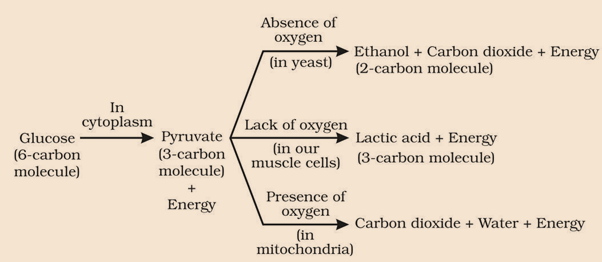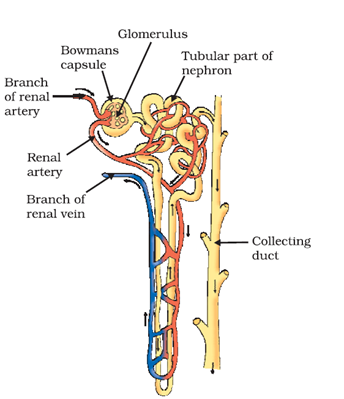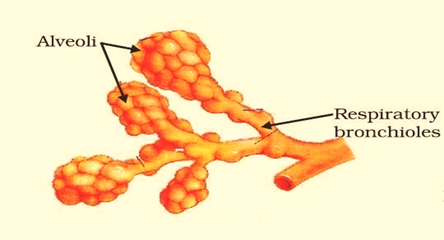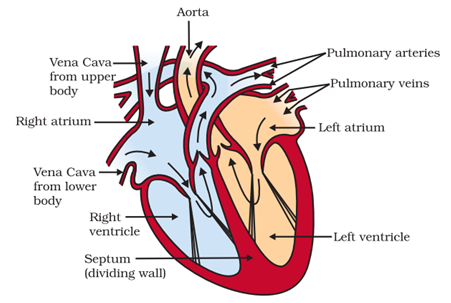NCERT Solutions for Class 10 Science Chapter 6 Life Processes
The Class 10 NCERT Solutions for Science Chapter 6 Life Processes includes all the intext and exercise questions. Class 10 Science Chapter 6 Life Processes NCERT questions and answers help students to clear their doubts and to obtain good marks in Class 10 board exam. All the solutions provided in this article are strictly based on the CBSE syllabus and curriculum.
Class 10 Science Chapter 6 NCERT Questions and Answers
Class 10 Science Chapter 6 Life Processes NCERT Questions and Answers are prepared by experts with a detailed explanation that will help students complete their assignments & homework. Having a good grasp over CBSE NCERT Solutions for Class 10 Science will further help the students in their preparation for board exams and other competitive exams such as NTSE, Olympiad, etc.
NCERT Solutions for Class 10 Science Chapter 6 Intext Questions
Intext Question (Page No. 95)
Question 1: Why is diffusion insufficient to meet the oxygen requirements of multicellular organisms like humans?
Answer: In multicellular organisms like humans, all the body cells are not in direct contact with the surrounding environment. Therefore, every cell of the body will not get oxygen as per need by the process of diffusion from the environment. Therefore, diffusion is insufficient to meet the oxygen requirements of multicellular organisms.
Question 2: What criteria do we use to decide whether something is alive?
Answer: Walking, breathing, growth and other visible changes can be used to determine whether something is alive or dead. However some living things will have changes that are not visible to our eye; Hence, presence of life process is a fundamental criteria to decide whether something is alive.
Question 3: What are outside raw materials used for by an organism?
Answer: An organism uses outside raw materials mostly in the form of food (Since life on earth depends on carbon-based molecules, most of these food sources are also carbon-based) and oxygen. The raw materials required by an organism can be quite varied depending on the complexity of the organism and its environment.
Question 4: What processes would you consider essential for maintaining life?
Answer: Life processes such as nutrition, respiration, transportation, excretion, etc. are essential for maintaining life.
Intext Question (Page No. 101)
Question 1: What are the differences between autotrophic nutrition and heterotrophic nutrition?
Answer:
| Autotrophic nutrition | Heterotrophic nutrition |
| Food is synthesized from simple inorganic raw materials such as CO2 and water. | Food is obtained directly or indirectly from autotrophs. This food is broken down with the help of enzymes. |
| Presence of green pigment (chlorophyll) is necessary. | No pigment is required in this type of nutrition. |
| Food is generally prepared during day time. | Food can be prepared at all times. |
| All green plants and some bacteria have this type of nutrition. | All animals and fungi have this type of nutrition. |
Question 2: Where do plants get each of the raw materials required for photosynthesis?
Answer: The following raw materials are required for photosynthesis:
- The raw material CO2 enters from the atmosphere through stomata.
- Water is absorbed from the soil by the plant roots.
- Sunlight, an important component to manufacture food, is absorbed by the chlorophyll and other green parts of the plants.
Question 3: What is the role of the acid in our stomach?
Answer: Role of the acid (HCl) in our stomach
- Kills germs present in the food.
- Makes the food acidic, so that pepsin can digest protein.
Question 4: What is the function of digestive enzymes?
Answer: Digestive enzymes such as amylase, lipase, pepsin, trypsin, etc. help in the breaking down of complex food particles into simple ones. These simple particles can be easily absorbed by the blood and thus transported to all the cells of the body.
Question 5: How is the small intestine designed to absorb digested food?
Answer: Small intestine has small projections called as micro villi which increases the surface volume which make absorption more effective. Within the villi there are numerous blood vessels that absorb digested food and carry it to blood stream. Blood transports food to each part of our body.
Intext Question (Page No. 105)
Question 1: What advantage over an aquatic organism does a terrestrial organism have with regard to obtaining oxygen for respiration?
Answer: Terrestrial organisms breathe by using atmospheric oxygen whereas aquatic organism take oxygen dissolved in water. Oxygen level is high in atmosphere when compared to oxygen in water. Hence terrestrial organism need not breathe fast to obtain organism whereas aquatic organisms need to breathe faster to get required oxygen.
Question 2: What are the different ways in which glucose is oxidized to provide energy in various organisms?
Answer: Glucose is first broken down in the cell cytoplasm into three carbon molecule called pyruvate. Pyruvate is further broken down in the following ways to provide energy:

Question 3: How is oxygen and carbon dioxide transported in human beings?
Answer: Oxygen and Carbon-di-oxide is transported in human being via blood stream. Oxygen is carried to the cells whereas carbon-di-oxide is carried away from the cells. Exchange of gases takes place between the alveoli of lungs and the surrounding blood capillaries. Oxygen is absorbed by the blood capillaries from the lungs alveoli by diffusion while carbon-dioxide is absorbed by the lungs alveoli from blood capillaries by diffusion.
Question 4: How are the lungs designed in human beings to maximise the area for exchange of gases?
Answer: The exchange of gases takes place between the blood capillaries that surround the alveoli and the gases present in the alveoli. Thus, alveoli are the site for exchange of gases. The lungs get filled up with air during the process of inhalation as ribs are lifted up and diaphragm is flattened. The air that is rushed inside the lungs fills the numerous alveoli present in the lungs. Each lung contains 300-350 million alveoli. These numerous alveoli increase the surface area for gaseous exchange making the process of respiration more efficient.
Intext Question (Page No. 110)
Question 1: What are the components of the transport system in human beings? What are the functions of these components?
Answer: The main components of the transport system in human beings are the heart, blood, and blood vessels.
Heart pumps oxygenated blood throughout the body. It receives deoxygenated blood from the various body parts and sends this impure blood to the lungs for oxygenation.
Blood is a fluid connective tissue, it helps in the transport of oxygen, nutrients, CO2, and nitrogenous wastes.
Blood vessels (arteries, veins, and capillaries) carry blood either away from the heart to various organs or from various organs back to the heart.
Question 2: Why is it necessary to separate oxygenated and deoxygenated blood in mammals and birds?
Answer: Mammals and birds are warm blooded animals which keep their body temperature constant irrespective of the environment they leave. This process require lot of oxygen for more cellular respiration so that warm blooded animals produce more energy to balance their body temperature. Hence it is very important for warm blooded animals to separate oxygenated and deoxygenated blood to keep their circulatory system efficient.
Question 3: What are the components of the transport system in highly organized plants?
Answer: In highly organized plants, there are two different types of conducting tissues − xylem and phloem.
Xylem conducts water and minerals obtained from the soil (via roots) to the rest of the plant.
Phloem transports amino acids and food materials from the leaves to different parts of the plant body.
Question 4: How are water and minerals transported in plants?
Answer: The components of xylem tissue (tracheids and vessels) of roots, stems and leaves are interconnected to form a continuous system of water – conducting channels that reaches all parts of the plant. Transpiration creates a suction pressure, as a result of which water is forced into the xylem cells of the roots. Then there is a steady movement of water from the root xylem to all the plant parts through the interconnected water – conducting channels.
Question 5: How is food transported in plants?
Answer: Phloem transports food materials from the leaves to different parts of the plant body. The transportation of food in phloem is achieved by utilizing energy from ATP. As a result of this, the osmotic pressure in the tissue increases causing water to move into it. This pressure moves the material in the phloem to the tissues which have less pressure. This is helpful in moving materials according to the needs of the plant. For example, the food material, such as sucrose, is transported into the phloem tissue using ATP energy.
Intext Question (Page No. 112)
Question 1: Describe the structure and functioning of nephrons.
Answer: Nephrons are the filtration units of the kidney which are large in numbers. Some substances in the initial filtrate, such as glucose, amino acids, salts and a major amount of water, are selectively re-absorbed as the urine flows along the tube. The main components of the nephron are glomerulus, Bowman’s capsule, and a long renal tubule.

Functioning of a nephron:
- The blood enters the kidney through the renal artery, which branches into many capillaries associated with glomerulus.
- The water and solute are transferred to the nephron at Bowman’s capsule.
- In the proximal tubule, some substances such as amino acids, glucose, and salts are selectively reabsorbed and unwanted molecules are added in the urine.
- The filtrate then moves down into the loop of Henle, where more water is absorbed. From here, the filtrate moves upwards into the distal tubule and finally to the collecting duct. Collecting duct collects urine from many nephrons.
- The urine formed in each kidney enters a long tube called ureter. From ureter, it gets transported to the urinary bladder and then into the urethra.
Question 2: What are the methods used by plants to get rid of excretory products?
Answer: Plants use completely different strategies for excretion than those animals. They can get rid of excess water by transpiration. For other wastes, plants use the fact that many of their tissues consist of dead cells, and that they can even lose some parts such as leaves. Many plant waste products are stored in cellular vacuoles. Waste products may be stored in leaves that fall off. Other waste products are stored as resins and gums, especially in old xylem. Plants also excrete some waste substances into the soil around them.
Question 3: How is the amount of urine produced regulated?
Answer: The amount of urine produced depends on the amount of excess water and dissolved wastes present in the body. Some other factors such as habitat of an organism and hormone such as Antidiuretic hormone (ADH) also regulates the amount of urine produced.
NCERT Solutions for Class 10 Science Chapter 6 Exercise Questions
Question 1: The kidneys in human beings are a part of the system for
(i) nutrition
(ii) respiration
(iii) excretion
(iv) transportation
Answer: (c) excretion.
Question 2: The xylem in plants are responsible for
(i) transport of water
(ii) transport of food
(iii) transport of amino acids
(iv) transport of oxygen
Answer: (a) transport of water.
Question 3: The autotrophic mode of nutrition requires
(i) carbon dioxide and water
(ii) chlorophyll
(iii) sunlight
(iv) all of the above
Answer: (c) sunlight.
Question 4: The breakdown of pyruvate to give carbon dioxide, water and energy takes place in
(i) cytoplasm
(ii) mitochondria
(iii) chloroplast
(iv) nucleus
Answer: (b) mitochondria.
Question 5: How are fats digested in our bodies? Where does this process take place?
Answer: Fats are present in the form of large globules in the small intestine. The small intestine gets the secretions in the form of bile juice and pancreatic juice respectively from the liver and the pancreas. The bile salts (from the liver) break down the large fat globules into smaller globules so that the pancreatic enzymes can easily act on them. This is referred to as emulsification of fats. It takes place in the small intestine.
Question 6: What is the role of saliva in the digestion of food?
Answer: Saliva is secreted by the salivary glands, located under the tongue. It makes the food soft for easy swallowing. It contains a digestive enzyme called salivary amylase, which breaks down starch into sugar.
Question 7: What are the necessary conditions for autotrophic nutrition and what are its byproducts?
Answer: Autotrophic nutrition takes place through the process of photosynthesis. Carbon dioxide, water, chlorophyll pigment, and sunlight are the necessary conditions required for autotrophic nutrition. Carbohydrates (food) and O2 are the byproducts of photosynthesis.
Question 8: What are the differences between aerobic and anaerobic respiration? Name some organisms that use the anaerobic mode of respiration.
Answer: Difference between Aerobic respiration and Anaerobic respiration:
| Aerobic respiration | Anaerobic respiration |
| It occurs in the presence of O2. | It occurs in the absence of O2 |
| It involves the exchange of gases between the organism and the outside environment. | Exchange of gases is absent. |
| It occurs in cytoplasm and mitochondria. | It occurs only in cytoplasm. |
| It always releases CO2 and H2O. | It produces alcohols and CO2. |
| It yields large amount of energy. | Energy released is very low. |
Question 9: How are the alveoli designed to maximize the exchange of gases?
Answer: The alveoli are the small balloon-like structures present in the lungs. The walls of the alveoli consist of extensive network of blood vessels. Each lung contains 300−350 million alveoli, making it a total of approximately 700 million in both the lungs. The alveolar surface when spread out covers about 80 m2 area. This large surface area makes the gaseous exchange more efficient.

Question 10: What would be the consequences of a deficiency of haemoglobin in our bodies?
Answer: Hemoglobin is a protein responsible for transportation of oxygen to the body cells for cellular respiration. Deficiency of Hemoglobin can affect the oxygen carrying capacity of RBC’S. This leads to lack of oxygen in our body cells. Hemoglobin deficiency leads to a disease called as anemia.
Question 11: Describe double circulation in human beings. Why is it necessary?
Answer: Because both oxygen and carbon dioxide have to be transported by the blood, the heart has different chambers to prevent the oxygen-rich blood from mixing with the blood containing carbon dioxide. The human heart is divided into four chambers − the right atrium, the right ventricle, the left atrium and the left ventricle.
Oxygen-rich blood from the lungs comes to the thin-walled upper chamber of the heart on the left, the left atrium. The left atrium relaxes when it is collecting this blood. It then contracts, while the next chamber, the left ventricle, expands, so that the blood is transferred to it. When the muscular left ventricle contracts in its turn, the blood is pumped out to the body.
De-oxygenated blood comes from the body to the upper chamber on the right, the right atrium, as it expands. As the right atrium contracts, the corresponding lower chamber, the right ventricle, dilates. This transfers blood to the right ventricle, which in turn pumps it to the lungs for oxygenation. During this process blood goes twice through the heart. That’s why it is known as double circulation.

Double Circulation is necessary: The separation of oxygenated and de-oxygenated blood allows a more efficient supply of oxygen to the body cells. This efficient system of oxygen supply is very useful in warm-blooded animals such as human beings. As we know, warm blooded animals have to maintain a constant body temperature by cooling themselves when they are in a hotter environment and by warming their bodies when they are in a cooler environment. Hence, they require more O2 for more respiration so that they can produce more energy to maintain their body temperature.
Thus, the circulatory system of humans is more efficient because of the double circulatory heart.
Question 12: What are the differences between the transport of materials in xylem and phloem?
Answer: Difference between Xylem and Phloem:
| Xylem | Phloem |
| Xylem tissue helps in the transport of water and minerals. | Phloem tissue helps in the transport of food. |
| Water is transported upwards from roots to all other plant parts. | Food is transported in both upward and downward directions. |
| Transport in xylem occurs with the help of simple physical forces such as transpiration pull. | Transport of food in phloem requires energy in the form of ATP. |
Question 13: Compare the functioning of alveoli in the lungs and nephrons in the kidneys with respect to their structure and functioning.
Answer:
| Alveoli | Nephron |
| Alveoli are functional unit of lungs. | Nephrons are functional unit of kidney. |
| A mature lung has about 30 crore alveoli. | A kidney has about 10 lakh nephrons. |
| Alveoli provide a wide surface for gaseous exchange. | The surface area of a nephron is not much more. |
| The exchange of O2 and CO2 takes place through the network of capillaries in alveoli. | The Bowman’s capsule in nephron regulates the concentration of water and salts. |
Topics covered under Class 10 Science Chapter 6 Life Processes
Below we have listed the topics discussed in NCERT Solutions for Class 10 Science Chapter 6. The list gives you a quick look at the different topics and subtopics of this chapter.
| Section in NCERT Book | Topics Discussed |
|---|---|
| 6.1 | What are Life Processes? |
| 6.2 | Nutrition |
| 6.3 | Respiration |
| 6.4 | Transportation |
| 6.5 | Excretion |
NCERT Solutions for Class 10 Science Chapter 6 – A Brief Discussion
Chapter Overview: The maintenance functions of living organisms must go on even when they are not doing anything particular. Even when we are just sitting in class, even if we are just asleep, this maintenance job has to go on. The processes which together perform this maintenance job are life processes. In this chapter you will learn some of the important life processes such as nutrition, respiration, transportation and excretion.